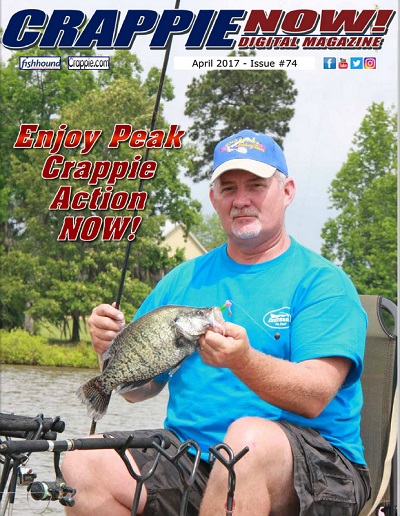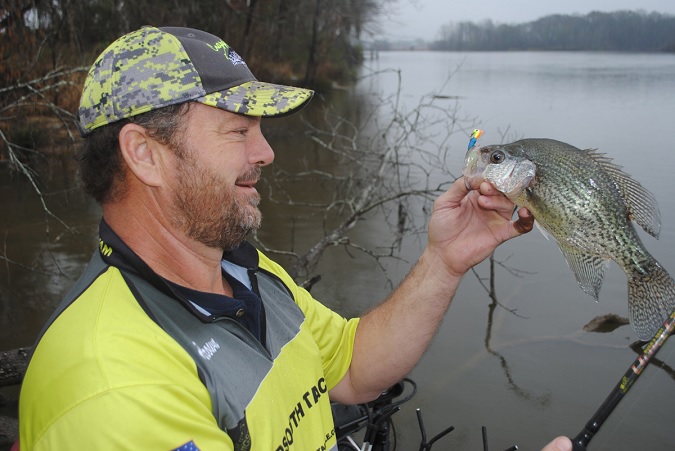 April is a great crappie fishing month with fish being active and in a variety of depths. CrappieNow Digital Magazine describes where, how and tips for catching crappie. Link – http://www.crappienow.com/cn/april2017/
April is a great crappie fishing month with fish being active and in a variety of depths. CrappieNow Digital Magazine describes where, how and tips for catching crappie. Link – http://www.crappienow.com/cn/april2017/
Super Shallow Crappie, Story & photos by Greg McCain
Crappie migrating to the shallows is one of the rituals of spring. Like children gleaning every last piece of Easter candy, anglers follow the frenzy as the fish stage through various depths. Very rarely are slabs as easily accessible or as easily caught as when they arrive in shallow water.
Of course, shallow is relative. Anglers on a southern impoundment might encounter shallow crappie spawning at 6 feet or more while their counterparts fishing natural lakes to the north in totally different depths.
But on almost every body of water, those glorious days arrive when the crappie are super shallow…fins-out-of-the-water shallow. Generally these fish are present in such skinny water – at all stages of the spawn – not just to propagate the species but to chase baitfish lured there by warmer water.
Tournament pro Steve Brown – half of the Midsouth Tackle team with Gerald Overstreet – anticipates the ritual every year. While he may not always seek super shallow crappie in competitive situations, he always follows the progression of fish from what he considers mid-depths, 6 out to about 15 feet, and expects to find crappie shallow from late winter throughout the spring.
“March, April, May, I’ve even caught fish full of eggs around the first of June (on the Alabama River),” Brown said.
He suggests the shallow pattern is one that both tournament competitors and fun fishermen alike should exploit for some of the hottest crappie action of the year. “That’s actually one of the ways that I learned to crappie fish,” Brown said. “Those fish always come to the bank in shallow water in the spring, and I first learned to catch them there.”
The parade to the shallows starts as early as February on Brown’s home waters, the upper Alabama River and the lower Coosa, both short drives from his home in Elmore.
“These fish are staging at the mouths of creeks waiting for the water temperature to stabilize at about 60 degrees for at least a couple of nights, and they are going to go to the bank,” Brown said.
“Black crappie are going to get as shallow as they can get. If they can get in 6 inches or a foot of water, then they are going to do it. The white crappie are going to stay out just a little deeper.”
Black crappie begin to move first. The males precede the females into the shallows and also linger longer. The egg-laden females hesitate until just the right moment and then proceed to make several trips into the shallows, Brown said.
“The females will be out in what I call your secondary ditch,” he said. “They are just waiting for the right time to go. Another thing that a lot of people don’t realize is that crappie don’t go in and spew all their eggs (at once). They will do it multiple times. They will move in and out … over at least a period of a few days.”
When the fish arrive, Brown scours shallow areas by spider rigging as long as the water is at least a couple of feet deep. Normally his rigging is simple, a vertical presentation on a 16-foot B’n’M BGJP pole, spinning reel filled with Gamma hi-vis 10-lb. mono, and a single jig.
Brown uses 1/16th– or 1/8th-oz. Timmy Tom’s weedless jigs and Road Runners in his pursuit of shallow crappie. He likes the weedless nature of the Timmy Tom’s jig but also favors the flash from the Road Runners, especially in stained water. Regardless of the head, Brown threads on a Midsouth Tackle Super Jig tube in colors conducive to water conditions, shad patterns in clearer water and more gaudy colors in stained water.
Brown creeps along at a snail’s pace, working into the wind as slow as 0.1 or 0.2 mph, using Humminbird electronics to identify likely holding areas. Stealth is vitally important in shallow water, and the electronics, long rods, and boat control help him avoid spooking fish.
“Cover is important year round no matter whether you are on a summer pattern or an early-spring pattern,” Brown said. “Wood plays a key. Stumps, brushpiles, and stakebeds are the type of structures that these fish relate to.”
Casting becomes the go-to approach when the fish move shallower than 2 feet. The draft of Brown’s Ranger rig prevents him from spider rigging in the extreme shallows. The boat, however, is equipped with PowerPoles, which can be used to slow the boat in trolling situations or to anchor it for casting.
“When those fish get super shallow, we will anchor down and cast to the bank or fan cast around the boat,” he said. He casts the same jig heads and plastics used for trolling and tosses them on a B’n’M spinning rod, downsizing his Gamma line to 6-lb. test. When the fish are this shallow in stained water, he will peg a float 6 to 18 inches up the line.
“The fish need a reason to be there,” Brown said. “They are not just going to show up. If you find fish that shallow, they will be there because the baitfish are that shallow.”
The results can be frenzied occasions that create pulse-pounding action for even the most seasoned angler.
“It gets absolutely crazy at times,” Brown said. “It’s fish after fish, probably the best opportunity of the year to quickly catch a lot of fish.”
For more on super shallow crappie along with other April tips and tactic, check out the April issue of CrappieNow Digital Magazine.
Other Stories To Look Forward To…
Keeping Fish Alive & Healthy, by Tim Huffman
Fishermen have the responsibility to care for the fish they catch. Here’s how to do it……read more
Streaming Into the Spawn, by John N. Felcher
Nothing signals crappie season like budding flowers, bushes and trees. Here are tips and tactics you need to know for river crappie…….read more
The Future of Crappie Tournaments: Part 5 of 7…Fish Care, Media & Tournament Costs, by Tim Huffman
Tournaments are a major influence on crappie fishing whether you compete or fish for recreation. New equipment and techniques often come from the tournament fishermen…..read more
